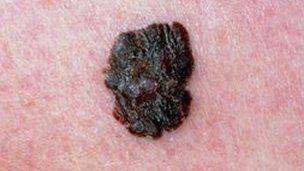Call for hairdressers to get skin cancer training
- Published

Removing suspicious moles early can prevent a deadly invasive melanoma developing
Hairdressers can and should be trained to check their clients for skin cancer, say health experts.
Currently there is no general screening programme in the UK, despite this cancer being one of the most common types.
It is estimated that about 100,000 new cases of skin cancer are diagnosed in the UK every year.
But many cases go undetected for years, meaning delayed treatment and a poorer outlook.
The most harmful type of skin cancer, called malignant melanoma, kills more than 2,500 people in the UK every year.
Most cases are preventable - skin cancer is caused by too much exposure to UV light from the sun or sunbeds - but the rates have been increasing over recent years.
People at greatest risk are those with fair, freckled skin and lots of moles.
Signs to be aware of include changes to moles, such as itching, bleeding or changing shape or colour.
In women, the cancers occur most commonly on the legs. For men, it is the back. But up to a fifth affect the skin of the head and neck.
Lesions on the scalp and the back of the neck can easily go unnoticed, and experts say hairdressers are the ideal people to spot these.
Untapped resource
Writing in the latest edition of the Journal of the American Academy of Dermatology, external, US doctors say: "We should not wait for our patients with skin cancer to come to us when it may be too late, but use research and outreach methods to improve early detection of head and neck melanomas by capitalising on the role of hairdressers and their unique relationship with our potential clients."
Hairdressers would not be expected to make the diagnosis, but instead to tactfully point out any lumps, bumps or sores they find to their client who can bring it to the attention of their own doctor.
Anecdotal research suggests such training is achievable, and work carried out by Nottingham City Hospital NHS Trust found of those hairdressers polled most were keen to do take on the extra responsibility.
Campaigners say the checks could become routine, alongside a cut and blow dry, in the UK's 36,000 hair salons.
In 2010, the Melanoma Taskforce, a panel of UK skin cancer experts chaired by Sian James MP, produced a set of guidelines for hairdressers and beauty therapists to help them identify malignant melanoma and two other common, less aggressive forms of skin cancer - basal cell carcinoma and squamous cell carcinoma.
A spokeswoman for the British Association of Dermatologists, a charity that is part of the taskforce, said: "It would be dangerous to suggest that such a small amount of 'training' qualifies health and beauty professionals to diagnose skin cancer.
"However, they can help in spotting changes to the skin in places that their clients can't usually see."
Sarah Williams, of Cancer Research UK, also part of the taskforce, said such strategies now needed evaluating to see whether they do achieve the desired effect.
She added: "Spotting skin cancer early makes treatment more likely to be successful. So it's important to raise awareness of the changes to look out for and encourage people to visit their GP if they notice anything unusual.
"Signs of skin cancer everyone can look out for include changes to the size, shape or colour of a mole, any other change to a mole or patch of skin, or a sore that hasn't healed after several weeks. If you notice any of these changes, it's best to get them checked out by a doctor without delay."
- Published23 February 2012
- Published15 July 2011